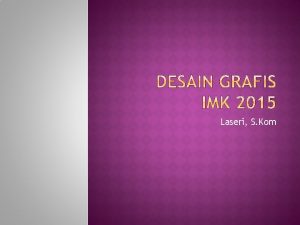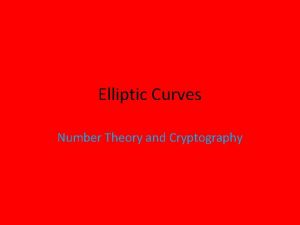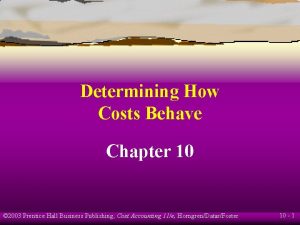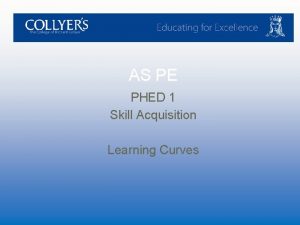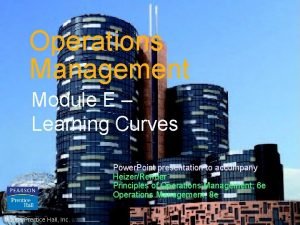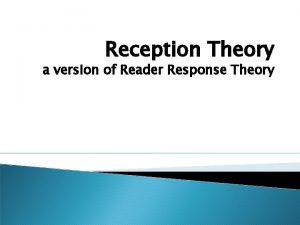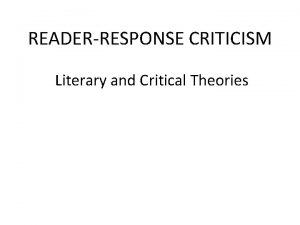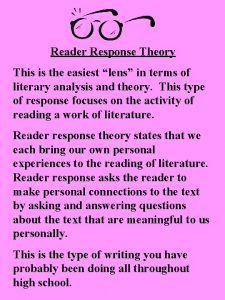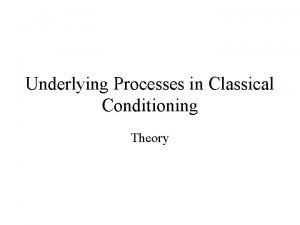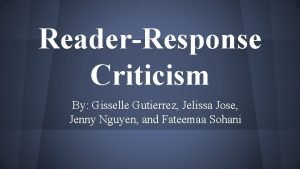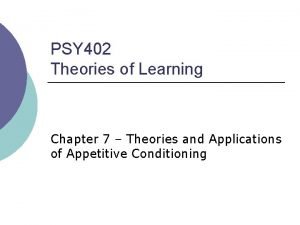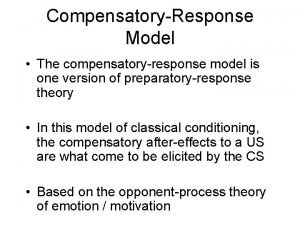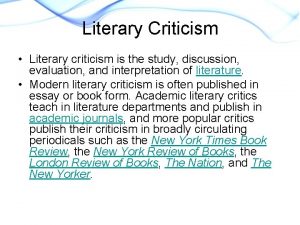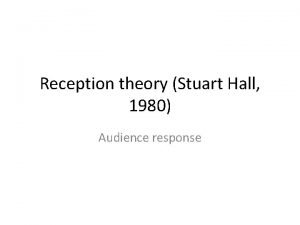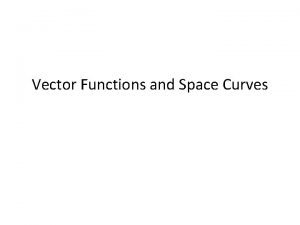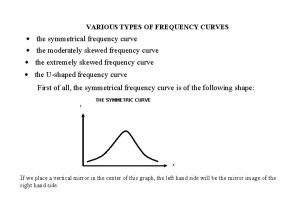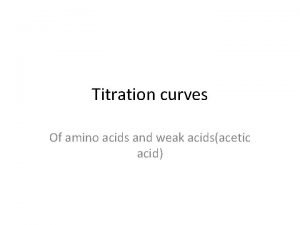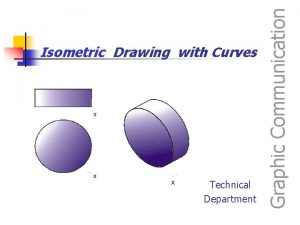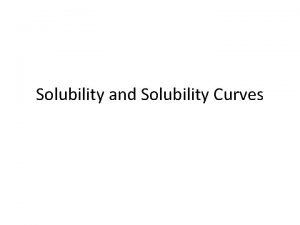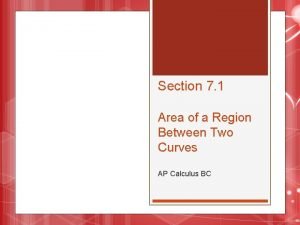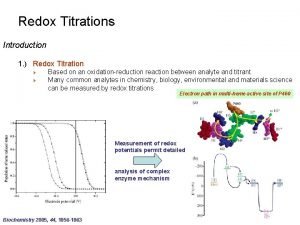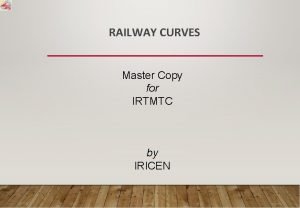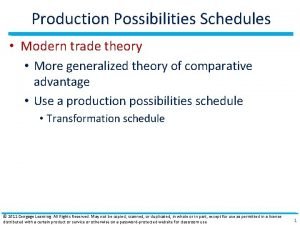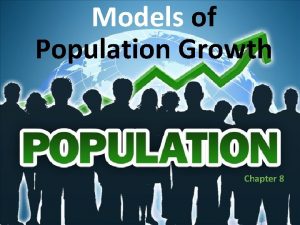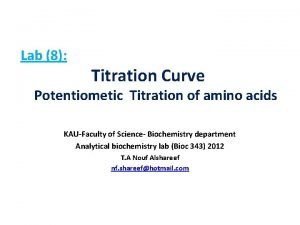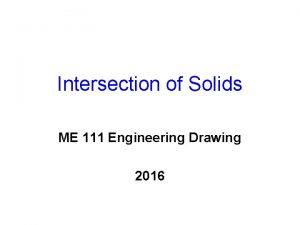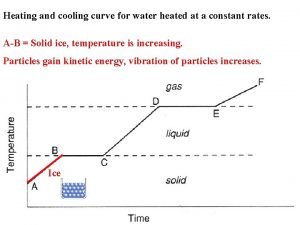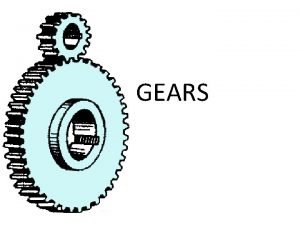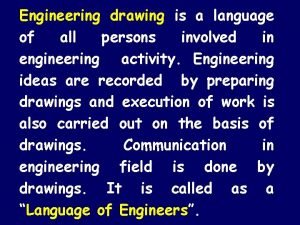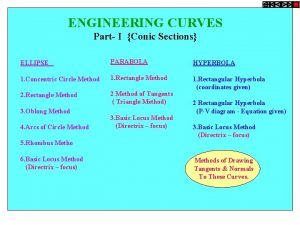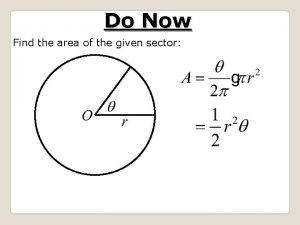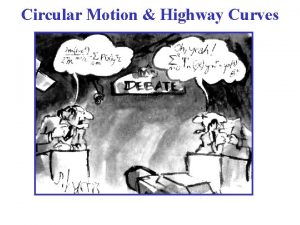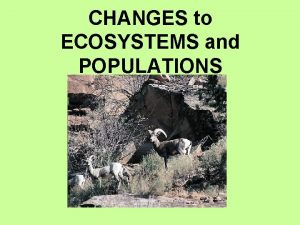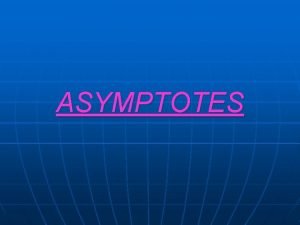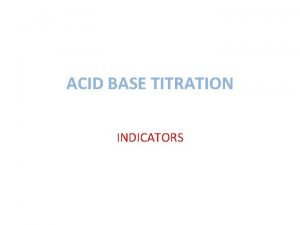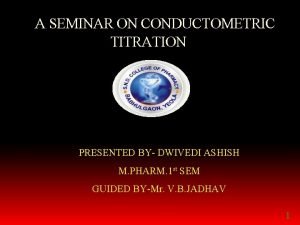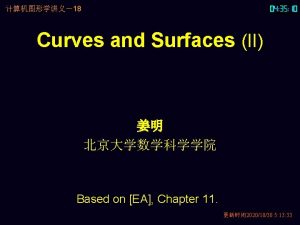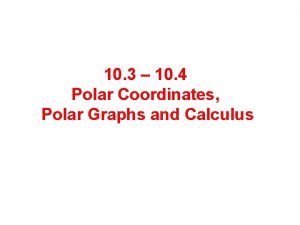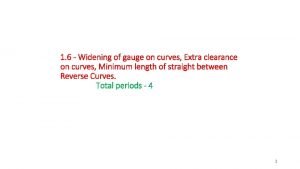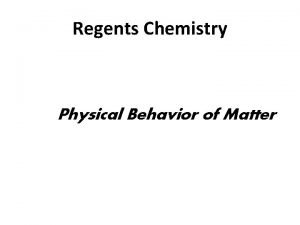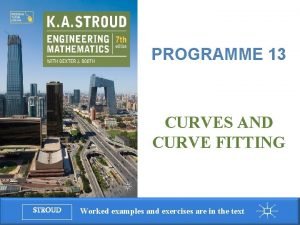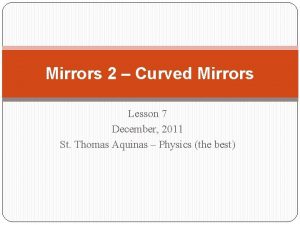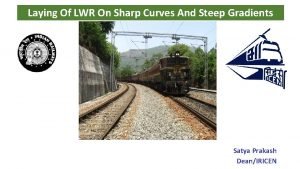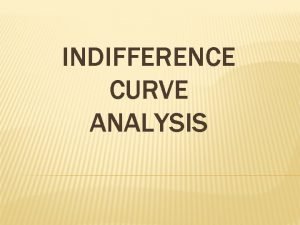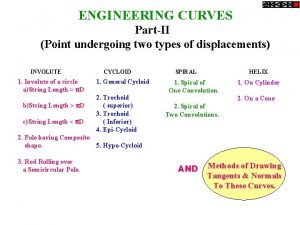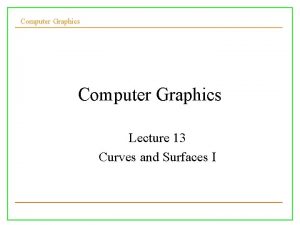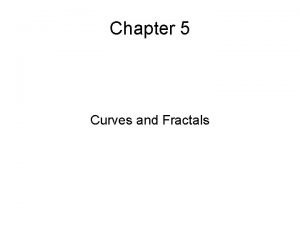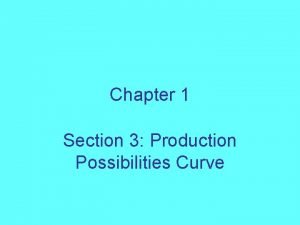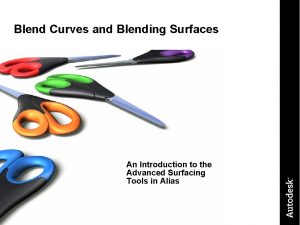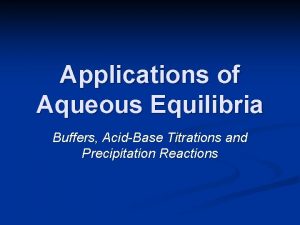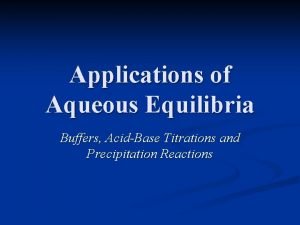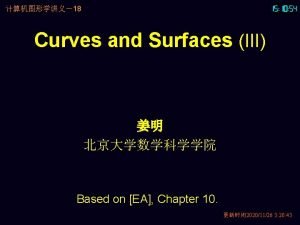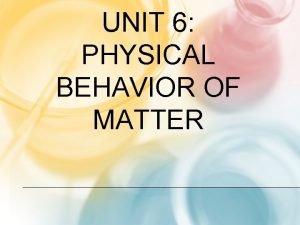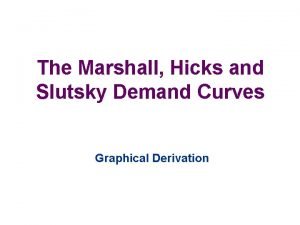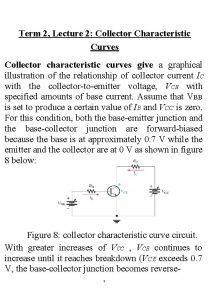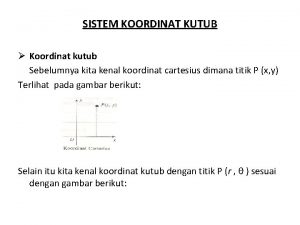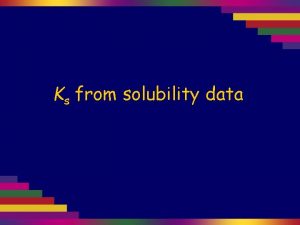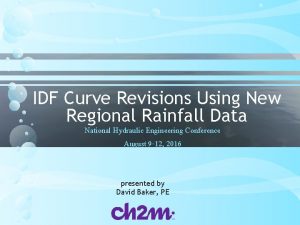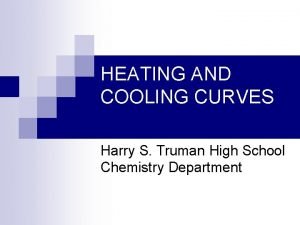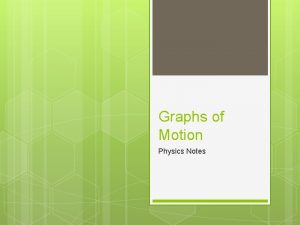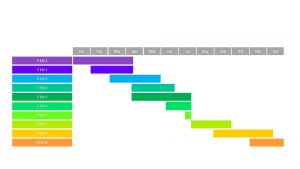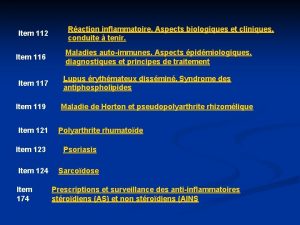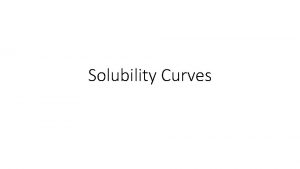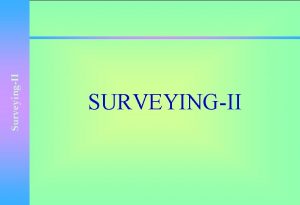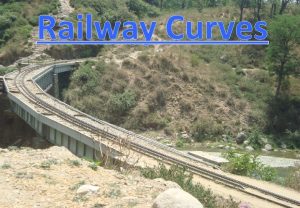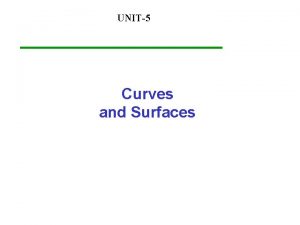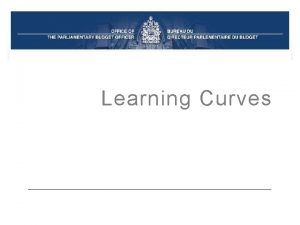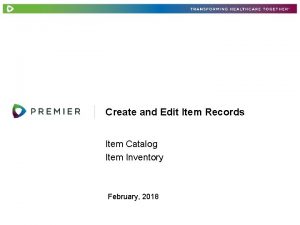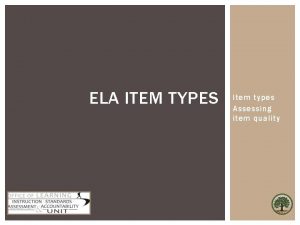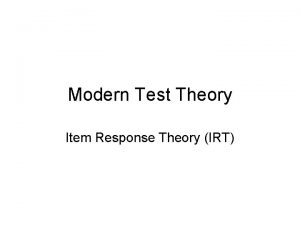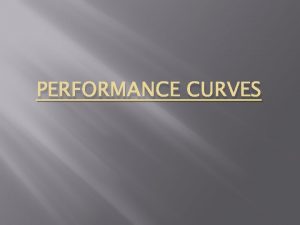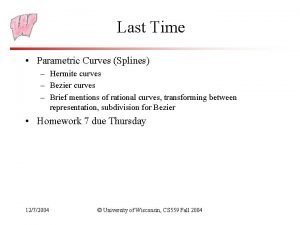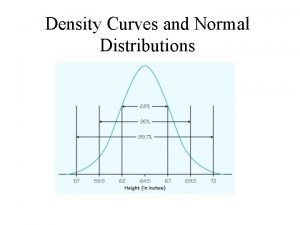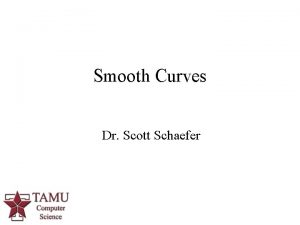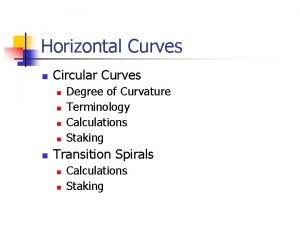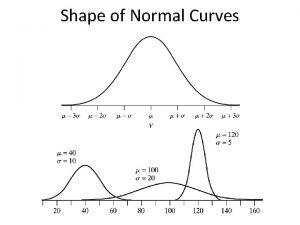Learning from Learning Curves Item Response Theory Learning






































































- Slides: 70

Learning from Learning Curves: Item Response Theory & Learning Factors Analysis Ken Koedinger Human-Computer Interaction Institute Carnegie Mellon University Cen, H. , Koedinger, K. , Junker, B. Learning Factors Analysis - A General Method for Cognitive Model Evaluation and Improvement. 8 th International Conference on Intelligent Tutoring Systems. 2006. Stamper, J. & Koedinger, K. R. Human-machine student model discovery and improvement using data. Proceedings of the 15 th International Conference on Artificial Intelligence in Education. 2011. 1

Cognitive Tutor Technology Use cognitive model to individualize instruction n Cognitive Model: A system that can solve problems in the various ways students can If goal is solve a(bx+c) = d Then rewrite as abx + ac = d 3(2 x - 5) = 9 If goal is solve a(bx+c) = d Then rewrite as abx + c = d If goal is solve a(bx+c) = d Then rewrite as bx+c = d/a 6 x - 15 = 9 2 x - 5 = 3 6 x - 5 = 9 • Model Tracing: Follows student through their individual approach to a problem -> context-sensitive instruction 2

Cognitive Tutor Technology Use cognitive model to individualize instruction n Cognitive Model: A system that can solve problems in the various ways students can If goal is solve a(bx+c) = d Then rewrite as abx + ac = d 3(2 x - 5) = 9 If goal is solve a(bx+c) = d Then rewrite as abx + c = d Hint message: “Distribute a across the parentheses. ” Known? = 85% chance 6 x - 15 = 9 Bug message: “You need to multiply c by a also. ” Known? = 45% 2 x - 5 = 3 6 x - 5 = 9 • Model Tracing: Follows student through their individual approach to a problem -> context-sensitive instruction • Knowledge Tracing: Assesses student's knowledge growth -> individualized activity selection and pacing 3

Cognitive Model Discovery n Traditional Cognitive Task Analysis q n Result: cognitive model of student knowledge q n Interview experts, think alouds, DFA Cognitive model drives ITS behaviors & instructional design decisions Key goal for Educational Data Mining q q q Improve Cognitive Task Analysis Use student data from initial tutor Employ machine learning & statistics to discover better cognitive models 4

Overview n n Using learning curves to evaluate cognitive models Statistical models of student performance & learning q q n n Example of improving tutor Comparison to other Psychometric models Using Learning Factors Analysis to discover better cognitive models Educational Data Mining research challenges 5

Mean Error Rate Student Performance As They Practice with the LISP Tutor 6

Production Rule Analysis Evidence for Production Rule as an appropriate unit of knowledge acquisition 7

Using learning curves to evaluate a cognitive model n Lisp Tutor Model q q n Learning curves used to validate cognitive model Fit better when organized by knowledge components (productions) rather than surface forms (programming language terms) But, curves not smooth for some production rules q “Blips” in leaning curves indicate the knowledge representation may not be right n q Corbett, Anderson, O’Brien (1995) Let me illustrate … 8

Curve for “Declare Parameter” production rule What’s happening on the 6 th & 10 th opportunities? n n How are steps with blips different from others? What’s the unique feature or factor explaining these blips? 9

Can modify cognitive model using unique factor present at “blips” n n Blips occur when to-be-written program has 2 parameters Split Declare-Parameter by parameter-number factor: q q Declare-first-parameter Declare-second-parameter (defun add-to (el lst) (append lst (list lst))) (defun second (lst) (first (rest lst))) 10

Can learning curve analysis be automated? n Manual learning curve analysis q q q n Identify “blips” in learning curve visualization Manually create a new model Qualitative judgment of fit Toward automatic learning curve analysis q q q Blips as deviations from statistical model Propose alternative cognitive models Evaluate cognitive model using prediction accuracy statistics 11

Overview n n Using learning curves to evaluate cognitive models Statistical models of student performance & learning q q n n Example of improving tutor Comparison to other Psychometric models Using Learning Factors Analysis to discover better cognitive models Educational Data Mining research challenges 12

Representing Knowledge Components as factors of items n n Problem: How to represent KC model? Solution: Q-Matrix (Tatsuoka, 1983) Items X Knowledge Components (KCs) Item Add Sub Mul Div 0 0 1 0 2*8 - 3 0 1 1 0 2*8 q q | KCs: Single KC item = when a row has one 1 Multi-KC item = when a row has many 1’s Q matrix is a bridge between a symbolic cognitive model & a statistical model 13

Additive Factors Model Assumptions n Logistic regression to fit learning curves (Draney, Wilson, Pirolli, 1995) n Assumptions about knowledge components (KCs) & students q q n Different students may initially know more or less Students generally learn at the same rate Some KCs are initially easier than others Some KCs are easier to learn than others These assumptions are reflected in a statistical model q q Intercept parameters for each student Intercept & slope parameters for each KC n Slope = for every practice opportunity there is an increase in predicted performance 14

Simple Statistical Model of Performance & Learning n n Problem: How to predict student responses from model? Solution: Additive Factor Model q i students, j problems/items, k knowledge components (KCs) Model parameters: Student intercept KC slope 15

Area Unit of Geometry Cognitive Tutor n Original cognitive model in tutor: 15 skills: Circle-area Circle-circumference Circle-diameter Circle-radius Compose-by-addition Compose-by-multiplication Parallelogram-area Parallelogram-side Pentagon-area Pentagon-side Trapezoid-area Trapezoid-base Trapezoid-height Triangle-area Triangle-side 16

Log Data Input to AFM Items = steps in tutors with stepbased feedback Q-matrix in single column: works for single KC items Opportunities Student has had to learn KC Student Step (Item) KC Opportunity Success A p 1 s 1 Circle-area 0 0 A p 2 s 1 Circle-area 1 1 A p 2 s 2 Rectangle-area 0 1 A p 2 s 3 Compose-byaddition 0 0 A p 3 s 1 Circle-area 2 0 17

AFM Results for original KC model Higher intercept of skill -> easier skill Higher slope of skill -> faster students learn it Skill Intercept Slope Avg Opportunties Initial Probability Avg Probability Final Probability 2. 14 -0. 01 14. 9 0. 95 0. 94 0. 93 -2. 16 0. 45 4. 3 0. 2 0. 63 0. 84 Parallelogram-area Pentagon-area Student Intercept student 0 1. 18 student 1 0. 82 student 2 0. 21 Higher intercept of student -> student initially knew more Model Statistics AIC 3, 950 BIC 4, 285 MAD 0. 083 The AIC, BIC & MAD statistics provide alternative ways to evaluate models MAD = Mean Absolute Deviation 18

Overview n n Using learning curves to evaluate cognitive models Statistical models of student performance & learning q q n n Example of improving tutor Comparison to other Psychometric models Using Learning Factors Analysis to discover better cognitive models Educational Data Mining research challenges 19

Application: Use Statistical Model to improve tutor n Some KCs over-practiced, others under (Cen, Koedinger, Junker, 2007) initial error rate 12% reduced to 8% after 18 times of practice initial error rate 76% reduced to 40% after 6 times of practice 20 20

“Close the loop” experiment n n n In vivo experiment: New version of tutor with updated knowledge tracing parameters vs. prior version Reduced learning time by 20%, same robust learning gains Knowledge transfer: Carnegie Learning using approach for other tutor units 7. 0 6. 0 5. 0 4. 0 Control 3. 0 Optimized 2. 0 1. 0 0. 0 Pre Post Retention 21 21

Additive Factor Model (AFM) generalizes Item Response Theory (IRT) n Instance of logistic regression q q n Generalization of item response theory (IRT) q q n Example: In R use generalized linear regression with family=binomial glm(prob-correct ~ student + KC: opportunity, family=binomial, …) IRT simply has i student & j item parameters glm(prob-correct ~ student + item, family=binomial, …) AFM is different from IRT because: q q It clusters items by knowledge components It has an opportunity slope for each KC 22

Comparing to other psychometric models n AFM adds a growth component to “LLTM” (Wilson & De Boeck) q q LTTM is an “item explanatory” generalization of IRT or “Rasch” “Person explanatory” models are related to factor analysis and other matrix factorization techniques 23

Model Evaluation n How to compare cognitive models? q n Model-data fit metrics q n A good model minimizes prediction risk by balancing fit with data & complexity (Wasserman 2005) Log likelihood, root mean squared error (RMSE), mean average deviation (MAD), area under curve (AUC), … Prediction metrics q BIC, AIC: Faster metrics add a penalty for # parameters n q BIC = -2*log-likelihood + num. Par * log(num. Ob) Cross validation: Slower but better n Split data in training & test sets, optimize parameters with training set, apply fit metrics on test set 24

A good cognitive model produces a learning curve Recall LISP tutor example above Without decomposition, using just a single “Geometry” skill, no smooth learning curve. But with decomposition, 12 skills for area, Rise in error rate because poorer students get assigned more problems a smooth learning curve. Is this the correct or “best” cognitive model? 25

Data. Shop visualizations to aid “blip” detection Many curves show a reasonable decline Some do not => Opportunity to improve model! 26

Learning Factors Analysis 27

Overview n n Using learning curves to evaluate cognitive models Statistical models of student performance & learning q q n n Example of improving tutor Comparison to other Psychometric models Using Learning Factors Analysis to discover better cognitive models Educational Data Mining research challenges 28

Learning Factors Analysis (LFA): A Tool for Cognitive Model Discovery n LFA is a method for discovering & evaluating alternative cognitive models q n Inputs q q n Finds knowledge components that best predict student performance & learning transfer Data: Student success on tasks in domain over time Codes: Factors hypothesized to drive task difficulty & transfer Outputs q q A rank ordering of most predictive cognitive models Parameter estimates for each model 29

Learning Factors Analysis (LFA) draws from multiple disciplines n Cognitive Psychology q n Learning curve analysis (Corbett, et al 1995) Psychometrics & Statistics q q q Q Matrix & Rule Space (Tatsuoka 1983, Barnes 2005) Item response learning model (Draney, et al. , 1995) Item response assessment models (Di. Bello, et al. , 1995; Embretson, 1997; von Davier, 2005) n Machine Learning & AI q Combinatorial search (Russell & Norvig, 2003) 30

Item Labeling & the “P Matrix”: Adding Alternative Factors n n How to improve existing cognitive model? Have experts look for difficulty factors that are candidates for new KCs. Put these in “P matrix” Q Matrix Item | Skill P Matrix Item | Skill Deal with negative 0 Order of Ops 0 Add Sub Mul 2*8 0 0 1 2*8 – 3 0 1 1 2*8 – 3 0 0 2*8 - 30 0 1 1 2*8 - 30 1 0 3+2*8 1 0 1 3+2*8 0 1 … 31

Using P matrix to update Q matrix n Create a new Q’ by using elements of P as arguments to operators q q Add operator: Q’ = Q + P[, 1] Split operator: Q’ = Q[, 2] * P[, 1] Q- Matrix after add P[, 1] Item | Skill Add Sub Mul Div 2*8 0 0 1 0 2*8 – 3 0 1 1 2*8 - 30 0 1 1 Q- Matrix after splitting P[, 1], Q[, 2] neg Item | Skill Add Sub Mul Div 0 2*8 0 0 1 0 Subneg 0 0 0 2*8 – 3 0 1 1 0 0 0 1 2*8 - 30 0 0 1 0 1 32

LFA: KC Model Search n n How to find best model given Q and P matrices? Use best-first search algorithm (Russell & Norvig 2002) q n Guided by a heuristic, such as BIC or AIC Do model selection within space of Q matrices Steps: 1. Start from an initial “node” in search graph using given Q 2. Iteratively create new child nodes (Q’) by applying operators with arguments from P matrix 3. Employ heuristic (BIC of Q’) to rank each node 4. Select best node not yet expanded & go back to step 2 33

Example in Geometry of split based on factor in P matrix Original Q matrix Factor in P matrix After Splitting New Q Circle-area by matrix Embed Revised Opportunity Student Step Skill Opportunity Embed Student Step Skill Opportunity A p 1 s 1 Circle-area 0 alone A p 1 s 1 Circle-area-alone 0 A p 2 s 1 Circle-area 1 embed A p 2 s 1 Circle-area-embed 0 A p 2 s 2 Rectangle-area 0 A p 2 s 3 Compose-by-add 0 A p 3 s 1 Circle-area 2 A p 3 s 1 Circle-area-alone 1 alone 34

LFA –Model Search Process • • Search algorithm guided by a heuristic: BIC Start from an existing cog model (Q matrix) Automates the process of hypothesizing alternative cognitive models & testing them against data Cen, H. , Koedinger, K. , Junker, B. (2006). Learning Factors Analysis: A general method for cognitive model evaluation and improvement. 8 th 35 International Conference on Intelligent Tutoring Systems.

Example LFA Results: Applying splits to original model Model 1 Model 2 Model 3 Number of Splits: 2 1. 1. 2. 3. n Binary split compose-by -multiplication by figurepart segment Binary split circleradius by repeat Binary split compose-by -addition by backward 2. 3. Binary split compose-bymultiplication by figurepart segment Binary split circle-radius by repeat Binary split compose-byaddition by figurepart areadifference 2. Binary split compose-bymultiplication by figurepart segment Binary split circle-radius by repeat Number of Skills: 18 Number of Skills: 17 BIC: 4, 248. 86 BIC: 4, 251. 07 Common results: q q Compose-by-multiplication split based on whether it was an area or a segment being multiplied Circle-radius is split based on whether it is being done for the first time in a problem or is being repeated 36

Compose-by-multiplication KC examples Composing Areas Composing Segments 37

Tutor Design Implications 1 n LFA search suggests distinctions to address in instruction & assessment With these new distinctions, tutor can q Generate hints better directed to specific student difficulties q Improve knowledge tracing & problem selection for better cognitive mastery n CM Example: Consider Compose-by-multiplication before LFA Intercept slope Avg Practice Opportunties Initial Probability Avg Probability Final Probability -. 15 . 1 10. 2 . 65 . 84 . 92 With final probability. 92, many students are short of. 95 mastery threshold 38

Tutor Design Implications 2 n However, after split: Intercept n Avg Practice Opportunties Initial Probability Avg Probability Final Probability CM -. 15 . 1 10. 2 . 65 . 84 . 92 CMarea -. 009 . 17 9 . 64 . 86 . 96 CMsegment -1. 42 . 48 1. 9 . 32 . 54 . 60 CM-area and CM-segment look quite different CM-area is now above. 95 mastery threshold (at. 96) But CM-segment is only at. 60 Original model penalizes students who have key idea about composite areas (CM-area) -- some students solve more problems than needed q q q n slope Instructional redesign implications: Change skillometer so CM-area & CM-segment are separately addressed q n q q Set parameters appropriately -- CM-segment with have a lower initial known value Add more problems to allow for mastery of CM-segment Add new hints specific to the CM-segment situation 39

Summary of Learning Factors Analysis (LFA) n n LFA combines statistics, human expertise, & combinatorial search to discover cognitive models Evaluates a single model in seconds, searches 100 s of models in hours q q n Model statistics are meaningful Improved models suggest tutor improvements Can currently be applied, by request, to any dataset in Data. Shop with at least two KC models 40

Mixed initiative humanmachine discovery 1. Human q Hypothesize possible “learning factors” and code steps 2. Machine q Search over factors, report best models discovered 3. Human q q q Inspect results If needed, propose new factors. Go to 2. If good, modify tutor and test. 41

Human-machine discovery of new cognitive models n Better models discovered in Geometry, Statistics, English, Physics 42

Some Open EDM Research Problems 43

Open Research Questions: Technical n What factors to consider? P matrix is hard to create q q q n Enhancing human role: Data visualization strategies Other techniques: Matrix factorization, Li. FT Other data: Do clustering on problem text Interpreting LFA output can be difficult q How to make interpretation easier? => Researcher can’t just “go by the numbers” 1) Understand the domain, the tasks 2) Get close to the data 44

Model search using Data. Shop: Human & machine improvements n Data. Shop datasets w/ improved KC models: q n New KCs (learning factors) found using Data. Shop visualization tools q q n Geometry Area (1996 -1997), Geometry Area Hampton 2005 -2006 Unit 34, … Learning curve, point tool, performance profiler Example of human “feature engineering” New KC models also discovered by LFA q Research goal: Iterate between LFA & visualization to find increasingly better KC models 45

Most curves “curve”, but if flat, then KC may be bad 46

Detecting planning skills: Scaffolded vs. unscaffolded problems n Scaffolded q Prompts are given for subgoals • Unscaffolded – Prompts are not given for subgoals (initially) 47

Discovering a new knowledge component n Each KC should have: 1. 2. 3. n smooth learning curve statistical evidence of learning even error rates across tasks Create new KCs by finding a feature common to hard tasks but missing in easy ones 1. Not smooth 2. No learning 3. Uneven error rate Easy tasks do not require subgoals, hard tasks do! 48

New model discovery: Split “compose” into 3 skills 1 2 3 n n Hidden planning knowledge: If you need to find the area of an irregular shape, then try to find the areas of regular shapes that make it up Redesign instruction in tutor q q Design tasks that isolate the hidden planning skill Given square & circle area, find leftover When prompts are initially present for component areas 49

Before unpacking compose-by-addition After -- unpacked into subtract, decompose, remaining compose-by-addition 50

3 -way split in new model (green) better fits variability in error rates than original (blue) 51

Automate human-machine strategies for “blip” detection n n Research goal: Automate low slope, non-low intercept, & high residual detection Uses: q q speed up LFA search point human coders to bad KCs n cluster harder vs. easier tasks 52

Developing & evaluating different learning curve models n Many papers in Educational Data Mining (EDM) conference q n Also in Knowledge Discovery & Data mining (KDD) Papers comparing knowledge tracing, AFM, PFA, CPFA, IFA q See papers by Pavlik, Beck, Chi … 53

Open Research Questions: Psychology of Learning n Change AFM model assumptions q Is student learning rate really constant? n n q Is knowledge space “uni-dimensional”? n q n Does a Student x KC interaction term improve fit? Need different KC models for different students/conditions? Is learning curve an exponential or power law? q n Does a Student x Opportunity interaction term improve fit? What instructional conditions or student factors change rate? Long-standing debate, which has focused on “reaction time” not on error rate! Compare use of Opportunity vs. Log(Opportunity) Other outcome variables: reaction time, assistance score Other predictors: Opportunities => Time per instructional event; Kinds of opportunities: Successes, failures, hints, gamed steps, … 54

Open Research Questions: Instructional Improvement n Do LFA results generalize across data sets? q q q n n Is AIC or BIC a good estimate for cross-validation results? Does a model discovered with one year’s tutor data generalize to a next year? Does model discovery work for ed games, other domains? Use learning curves to compare instructional conditions in experiments Need more “close the loop” experiments q EDM => better model => better tutor => better student learning 55

END 56

To do n Shorten – by how much? q q n Put “other” alternatives at end q q n n n Which slides to delete? Remove details on geometry model application Cottage industry in EDM & KDD Papers comparing knowledge tracing, AFM, PFA, CPFA, IFA … see Pavlik, Beck, Chi … Table with LFA search results Demo parts of Data. Shop? Add some interactive questions q Use Learning Objectives to aid that 57

If time: Data. Shop Demo and/or Video n n See video on “about” page “Using Data. Shop to discover a better knowledge component model of student learning” 58

Before unpacking compose-by-addition After -- unpacked into subtract, decompose, remaining compose-by-addition 59

Detecting planning skills: Scaffolded vs. unscaffolded problems n Scaffolded q Columns given for area subgoals n Unscaffolded q Columns not given for area subgoals 60

Knowledge Decomposibility Hypothesis n n Human acquisition of academic competencies can be decomposed into units, called knowledge components (KCs), that predict student task performance & transfer Performance predictions q q n q Example of Items & KCs KC 1 KC 2 KC 3 add carry subt 0 0 I 2: 15+7 1 1 If item I 1 requires KC 1, & item I 3 also requires KC 1, I 3: 4+2 1 0 then practice on I 3 will improve I 1 I 4: 5 -3 0 0 If item I 1 requires KC 1, & item I 4 requires only KC 3, then practice on I 4 will not improve I 1 0 Transfer predictions q n If item I 1 only requires KC 1 & item I 2 requires both KC 1 and KC 2, then item I 2 will be harder than I 1 If student can do I 2, then they can do I 1: 5+3 1 0 1 Fundamental EDM idea: q We can discover KCs (cog models) by working these predictions backwards! 61

Using Student Data to Make Discoveries Research base Practice base Cognitive Psychology Artificial Intelligence Educators Standards Design Cognitive Tutor courses: Tech, Text, Training Discover Deploy Cognition, learning, instruction, context Address social context Data Qual, quant; process, product 62

Cognitive Task Analysis is being automated n n n Use ed tech to collect student data Develop data visualizations & model discovery algorithms Machine learning systems & cognitive scientists working together Cen, Koedinger, Junker (2006). Learning Factors Analysis: A general method for cognitive model evaluation and improvement. Intelligent Tutoring Systems. 63

Can this data-driven CTA be brought to scale? n Combine Cognitive Science, Psychometrics, Machine Learning … n n Collect a rich body of data Develop new model discovery techniques n PSLC & Data. Shop are facilitating 64

Cognitive modeling from symbolic to statistical n Abstract from a computational symbolic cognitive model to a statistical cognitive model n For each task label the knowledge components or skills that are required: Q Matrix Add Sub Mul 2*8 0 0 1 2*8 – 3 0 1 1 2*8 - 30 0 1 1 3+2*8 1 0 1 65

Geometry Tutor Scaffolding problem decomposition Problem decomposition support 66

Good Cognitive Model => Good Learning Curve n n An empirical basis for determining when a cognitive model is good Accurate predictions of student task performance & learning transfer Repeated practice on tasks involving the same skill should reduce the error rate on those tasks => A declining learning curve should emerge q 67

Statistical Model of Student Performance & Learning “Additive Factor Model” (AFM) (cf. , Draney, Pirolli, Wilson, 1995) • Evaluate with BIC, AIC, cross validation to reduce over-fit 68

Comparing to other psychometric models n Adds a growth component to “LLTM” (Wilson & De Boeck) q q LTTM is an “item explanatory” generalization of Rasch/IRT AFM is “item learning explanatory” 69

Automating the Cognitive Model Discovery Process Learning Factors Analysis n Input: Factors that may differentiate tasks n Output: Best cognitive model Cen, H. , Koedinger, K. , Junker, B. (2006). Learning Factors Analysis: A general method for cognitive model evaluation and improvement. 8 th International Conference on Intelligent Tutoring Systems. 70
 Item-item yang berkaitan ditampilkan bersama
Item-item yang berkaitan ditampilkan bersama Elliptic curves number theory and cryptography
Elliptic curves number theory and cryptography Learning curves 2003
Learning curves 2003 Learning curves in sport
Learning curves in sport Learning curve coefficient table
Learning curve coefficient table Natural response and forced response
Natural response and forced response First order system transfer function
First order system transfer function Primary immune response and secondary immune response
Primary immune response and secondary immune response Reader response and reception theory
Reader response and reception theory Reader response criticism
Reader response criticism Personal response lens
Personal response lens Ss learning
Ss learning Reader response criticism
Reader response criticism Response deprivation theory
Response deprivation theory Compensatory responses
Compensatory responses Feminist criticism example
Feminist criticism example Audience response theory
Audience response theory Find the domain of the vector function
Find the domain of the vector function J shaped frequency curve
J shaped frequency curve Aspartate titration curve
Aspartate titration curve Isometric drawing curves
Isometric drawing curves The zoo dangerous curves
The zoo dangerous curves Solubility curves definition
Solubility curves definition Area between two curves formula
Area between two curves formula What is redox titration
What is redox titration Degree of curve in railway
Degree of curve in railway Creating production possibilities schedules and curves
Creating production possibilities schedules and curves S and j curves
S and j curves Uses of convex mirror
Uses of convex mirror Titration curve of amino acids
Titration curve of amino acids Intersection of two cylinders engineering drawing
Intersection of two cylinders engineering drawing Heat curve
Heat curve Lewis equation
Lewis equation Define hyperbola in engineering drawing
Define hyperbola in engineering drawing Engineering curves
Engineering curves Area of polar curves practice
Area of polar curves practice Highway curves banked and unbanked
Highway curves banked and unbanked S and j curves
S and j curves Fully bilateral balanced occlusion
Fully bilateral balanced occlusion Asymptotes parallel to x axis is obtained by equating the
Asymptotes parallel to x axis is obtained by equating the Acid base titration curves
Acid base titration curves Types of conductometry
Types of conductometry 18 curves com
18 curves com Arc length polar
Arc length polar Widening of gauge on curves
Widening of gauge on curves Curriculum guide for driver education in virginia module 5
Curriculum guide for driver education in virginia module 5 Physical behavior of matter heating and cooling curves
Physical behavior of matter heating and cooling curves Reading solubility curves
Reading solubility curves 13 curves
13 curves Convex mirror uses
Convex mirror uses Steep grade sharp curves
Steep grade sharp curves Assumptions of indifference curve
Assumptions of indifference curve Nelson curves
Nelson curves Construct a helix with radius 40mm
Construct a helix with radius 40mm Hermite curve in computer graphics
Hermite curve in computer graphics Fractals deals with curves that are
Fractals deals with curves that are Chapter 1 section 3 production possibilities curves
Chapter 1 section 3 production possibilities curves Blending curve
Blending curve Why do titration curves flatten out
Why do titration curves flatten out Why do titration curves flatten out
Why do titration curves flatten out 18 curves
18 curves Physical behavior of matter heating and cooling curves
Physical behavior of matter heating and cooling curves Marshallian vs hicksian demand
Marshallian vs hicksian demand Collector characteristic curves
Collector characteristic curves Grafik persamaan kutub
Grafik persamaan kutub Pes curves
Pes curves Solubility curve calculator
Solubility curve calculator Noaa idf curves
Noaa idf curves Heating curve
Heating curve When two curves coincide the two objects have the same
When two curves coincide the two objects have the same A 2d area enclosed by lines or curves
A 2d area enclosed by lines or curves
